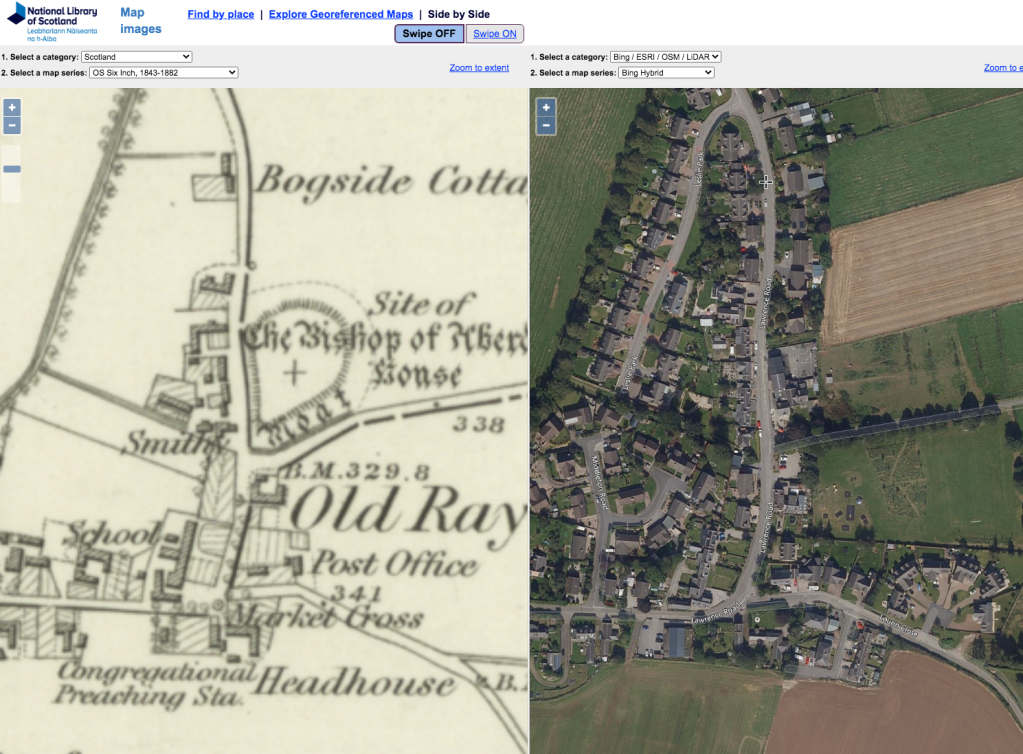
Old Rayne today is a small sleepy village some 5 km east of Insch just north of the main A96 Aberdeen to Inverness trunk road. Now small, it was once an important church and market centre. The lands of Rayne were granted to the bishopric of Aberdeen in 1137. There was once a residence of the Bishop Alexander Kinninmonth (Bishop of Aberdeen 1329-40). Kinninmonth died in 1340 and it is recorded that the house was not yet complete at that time. By 1845 nothing remained of the residence but ‘a small rising ground… surrounded by a moat…’. The site though was still marked on the OS map of 1870. In 1901 the village school was built over the site and further development and agriculture have obliterated the remains.

Today the only sign of an important market is the remains of the mercat cross, an octagonal 3m high shaft on its plinth of 5 circular steps it is topped with an iron Saltire. According to Canmore, ‘The New Statistical Account (NSA) and SDD state that the cross probably dates from the late 17th century, but Jervise (1875-9) mentions that in 1472, Bishop Elphinstone was empowered to erect a cross’ so it is possible that it is some 2 centuries older than thought.


If one follows the road to the left of the mercat cross for about a mile the remains of a Stone Circle can be found in a field just off the road. This is the remains of a recumbent stone circle known variously as Candle Hill, Tap o Mast or plainly just Old Rayne. District Head Courts held here in medieval times. The circle has only has one standing stone but still merits an entry in Burl’s Guide to Stone Circles though as he says ‘Only its excavation justifies the inclusion … of such a dreadfully ruined recumbent stone circle. In a ring once about 87ft in diameter only one stone at the south-east still stands. The rest are a megalithic dismay. Look but do not linger.’

Before Dalrymple’s excavation moved them in 1856-7, there were twelve stones though today only eight remain. Dalrymple found a central, oblong layer of stones 2 1/2ft deep, in which was a pit 2ft in diameter containing burnt bones; charcoal; fragments of an urn; and part of a polished green stone archer’s wristguard. Other small deposits of bones occurred around this pit. The contents of another pit 5ft deep included black mould and fire-marked boulder stones.

Most of the stones have been severely damaged and broken – probably for use as building materials. The single orthostat that remains standing is on the has had a lucky escape, as can be seen from the iron wedges embedded in several of the fissures in its outer face though at least two large chunks of rock have been removed from it – when I visited a rusty horseshoe was placed here. The remaining stones were hard to figure out -jumbled as they were amongst overgrowth – a winter visit might be more revealing.

According to Canmore:
‘Of the other four orthostats (5–8 ), at least one (8) is displaced, now lying immediately N of the W flanker, and it is not clear how close to their sockets the other three lie; the earliest record of the diameter of the circle by James Skene is in the order of 15.5m, while Charles Dalrymple put it at about 18m, both considerably less than the circle of 26.5m that best fits the stones in their present positions. This bigger diameter, however, coincides with a swelling in the surface of the field revealed by profiles measured across the ring, particularly that from N to S (X–X1). Despite the complete absence of any cairn material in the plough-soil in the interior of the circle, this swelling is likely to be an artificial mound, within which Charles Dalrymple discovered a large central pit; the stones of the circle apparently stood upon the skirts of this mound (see discussion below). The purpose of a deeply embedded boulder (A) behind the E flanker is not known. It possibly belonged to a later structure that once incorporated the recumbent setting’.
